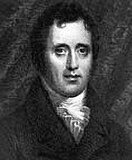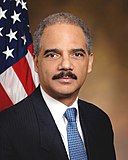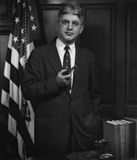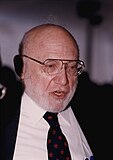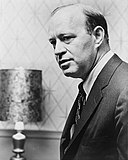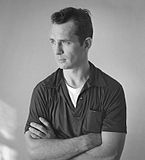Columbia College, Columbia University
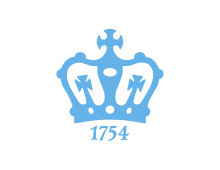 | |
| Type | Private |
|---|---|
| Established | 1754 |
Parent institution | Columbia University |
| Dean | Josef Sorett |
| Students | 4,500[1] |
| Location | , , United States |
| Website | www |
Columbia College is the oldest
Columbia College is distinctive for its comprehensive Core Curriculum and is among the most selective of American colleges, with an admission rate of 3.85% in 2024.
History

Columbia College was founded as King's College in 1754 in the
The college chose
Park Place Campus
By 1760, Columbia had relocated from the Trinity Church site to one along Park Place, near the city commons and today's New York City Hall.
In 1767, Samuel Bard established a medical college at the school, now known as the Columbia University College of Physicians and Surgeons, which was the first medical school to grant the Doctor of Medicine (M.D.) degree in America.
Due to the
Hamilton's first experience with the military came while a student during the summer of 1775, after the outbreak of fighting at
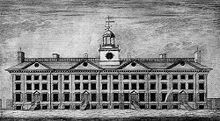
With the successful Treaty of Paris in 1783, the domestic situation was stable enough for the college to resume classes in 1784. With the new nation's independence from the Kingdom of Great Britain, the name of the institution was changed from King's College to Columbia College, the name by which the institution continues to be known today. The college was briefly chartered as a state institution, lasting only until 1787, when due to a lack of public financial support the school was permitted to incorporate under a private board of trustees. This 1787 charter remains in effect. The renamed and reorganized college, located in the new national capital under the Constitution and free from its association with the Church of England, received students from a variety of denominations as a response to its growing reputation as one of the finest institutions of higher learning in the new nation.[citation needed]
Midtown Campus
Columbia was located at its Park Place campus near
During the college's forty years at this third location, in addition to granting the Bachelor of Arts and Doctor of Medicine degrees, the faculties of the college were expanded to include the Columbia Law School (founded 1858), the Columbia School of Mines (founded 1864, now known as the Fu Foundation School of Engineering and Applied Science). The Columbia School of Mines awarded the first Ph.D. from Columbia in 1875.
At this time, Columbia College was now not only the name of the original undergraduate college founded as King's College, but it also encompassed all of the other colleges and schools of the institution. (Though technically known as the "School of Arts", the undergraduate division was often called "The College proper" to avoid confusion.) After Seth Low became president of Columbia College in 1890, he advocated the division of the individual schools and colleges into their own semi-autonomous entities under the central administration of the university. The complexity of managing the institution had been further increased when Barnard College for Women became affiliated with Columbia in 1889 followed by Teachers College of Columbia University in 1891. Also by this time, graduate faculties issuing the Doctor of Philosophy (Ph.D.) degree in philosophy, political science, and the natural sciences had also developed.
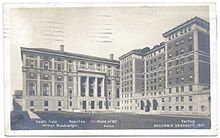
Thus, in 1896, the trustees of Columbia College, under the guidance of Seth Low, approved a new name for the university as a whole, Columbia University in the City of New York. At this point, the name Columbia College returned to being used solely to refer to the original undergraduate college, founded as King's College in 1754 and renamed Columbia College in 1784.
Move to Morningside Heights
In addition to reclaiming the identity of Columbia College and making it the focus of the newly rearranged
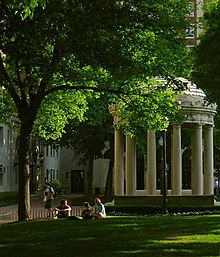
The academic history of traditions of Columbia College clearly had their beginnings in the classical education of the Enlightenment, and in this mold, the college's famous Core Curriculum was officially recognized and codified in 1919 with John Erskine's first seminar on the great books of the western tradition. Also in 1919, a course, War and Peace, was required of all Columbia College students in addition to the Great Books Honors Seminar.
During the 1960s, Columbia College, like many others across the United States, experienced unrest and turmoil due to the ongoing
After two committees reported in 1980 and 1981 that the all-male college's competitiveness with other Ivy League universities was decreasing, women were admitted in 1983.
Columbia College today

Admissions
Like other elite schools, Columbia has been attracting ever higher numbers of applicants, with a trend towards applicants appling to more than seven different institutions – an increasingly "scattershot approach" when compared to applications in the 1990s.[8] Columbia College (including Columbia Engineering) has an admittance rate that places it among the most selective of American colleges.[9] For the fall term of 2010, there were 26,178 applicants for 2,397 placements in the Class of 2014, for an acceptance rate of 9.16%.[10] By the fall term of 2024, applications had more than doubled, with 60,248 applicants for 2,319 placements in the Class of 2028, for an acceptance rate of 3.85%.[11]
Academics
Columbia College has long been known for its rigorous
Students are also required to pass a swimming test before receiving their diploma. The foreign language requirement, however, may be skipped if the student passes a placement exam or demonstrates requisite proficiency. Most students graduate within four years with a Bachelor of Arts degree.
Campus

Most of the college's facilities are located on Columbia University's Morningside Heights campus, especially in Hamilton Hall, which houses its administrative and admissions offices, as well as the directors of the Core Curriculum.
Students at Columbia College are guaranteed campus housing for four years. Residence halls, which also house undergraduate students of Columbia's engineering school, are either located on the Morningside Heights main campus or within 10 blocks of the 116th Street entrance. First-year students are housed on the main quad in John Jay, Carman, Wallach, Hartley and Furnald Halls.
The two main dining facilities are John Jay Dining Hall and Ferris Booth Commons; all freshmen are required to have a full meal plan. Other school dining facilities available on the Morningside Heights campus are located in the recently remodeled student center, Alfred Lerner Hall, Faculty House,[13] and Uris Hall.
Governance
In 2011, after the resignation of Michele Moody-Adams, James Valentini replaced her as Dean of Columbia College. The students of Columbia College elect the Columbia College Student Council (CCSC) to serve as their primary representative, advocate, and liaison to the Columbia University community, including its administration, faculty, alumni and students, as well as to the public.
The college's board of visitors is an independent and self-governing advisory body composed of college alumni and parents. The board advocates for the interest of the college among the Columbia community, New York city and beyond. It also provides advice to the dean in identifying and addressing both immediate challenges and short-and long-term opportunities for the college. Members of the board currently include ZhenFund CEO Anna Fang, JP Morgan Chase global head of research Joyce Chang, Virtu Financial CEO Doug Cifu, Academy Award-winning producer Dede Gardner, former NYC Commissioner for Consumer and Worker Protection Peter Hatch, USRowing Chairman and president Nobuhisa Ishizuka, HEICO co-president Eric Mendelson, Sixth Street Partners co-founder Vijay Mohan, Warner Bros. General Counsel John Rogovin, Morgan Stanley's global head of technology Robert Rooney, HNA Group CEO Tan Xiangdong, former FTC Commissioner Mozelle W. Thompson, Happy Family CEO Shazi Visram, and hedge fund manager William von Mueffling.[14]
Former members of the board count among them PBS president Lawrence K. Grossman, Thomson Reuters CEO Tom Glocer, hedge fund manager Mark E. Kingdon, Bain Capital co-managing partner Jonathan Lavine, Univision CFO Frank Lopez-Balboa, airline investor Frank Lorenzo, real estate developer Philip L. Milstein, H.I.G. Capital founder Sami Mnaymneh, KKR executive Alex Navab, C-SPAN co-founder Robert Rosencrans, Tishman Speyer CEO Rob Speyer, healthcare entrepreneur Daniel E. Straus.[15]
List of Deans of Columbia College
- 1896–1910 John Howard Van Amringe[16]
- 1910–1917 Frederick Paul Keppel
- 1918–1943 Herbert Hawkes
- 1943–1950 Harry J. Carman
- 1950–1958 Lawrence Henry Chamberlain
- 1958–1962 John Gorham Palfrey
- 1963–1967 David B. Truman
- 1967–1968 Henry S. Coleman (interim)[17]
- 1968–1972 Carl Hovde
- 1972–1976 Peter Pouncey
- 1976–1977 Robert L. Belknap (acting)
- 1977–1982 Arnold Collery
- 1982–1989 Robert Pollack
- 1989–1993 Jack Greenberg
- 1993–1995 Steven Marcus
- 1995–2009 Austin Quigley
- 2009–2011 Michele Moody-Adams
- 2011–2022 James J. Valentini
- 2022–Present Josef Sorett
Noted people
Many eminent individuals have attended or taught at Columbia College or King's College, its predecessor.
Among those College alumni categorized as "remarkable" by the university during its 250th anniversary celebrations in 2004
Academics listed include philosophers
Public intellectuals and journalists, including broadcaster Roone Arledge, social critic Randolph Bourne, environmentalist Barry Commoner, and writers like Henry Demarest Lloyd and Norman Podhoretz are also prominent on the list. Major publishers included were Alfred Knopf, Arthur Sulzberger, and Bennett Cerf. Rabbi Stephen Wise is also considered prominent.
Columbia College graduates recognized in the arts include pianist
Architects
Additionally, highly visible former Columbia College students in recent years include former President
Among its graduates and attendees, Columbia College can count at least 16
- Notable Columbia College alumni include:
-
Founding Father of the United States; author of The Federalist Papers; 1st United States Secretary of the Treasury
-
John Jay: Founding Father of the United States; author of The Federalist Papers; 1st Chief Justice of the United States; 2nd Governor of New York
-
New York
-
United States Secretary of Foreign Affairs, negotiator of the Louisiana Purchase
-
Hamilton Fish: 26th United States Secretary of State; United States Senator from New York; 16th Governor of New York
-
vice president of the United Statesfrom 1817 to 1825
-
Illinois; Nobel laureate
-
William Barr: 77th and 85th United States Attorney General
-
Eric Holder: 82nd United States Attorney General
-
Chairman of the Federal Reserve and former U.S. Ambassador to West Germany
-
Julian S. Schwinger: Nobel laureate; pioneer of quantum field theory; one of the greatest physicists of the 20th century
-
Joshua Lederberg, biologist, winner of the 1953 Nobel Prize in Physiology or Medicine
-
Leon Cooper, physicist, winner of the 1972 Nobel Prize in Physics
-
Richard Axel, biologist, winner of the 2004 Nobel Prize in Physiology or Medicine
-
Robert Lefkowitz, biochemist, winner of the 2012 Nobel Prize in Physiology or Medicine
-
Arthur Ashkin, winner of the Nobel Prize in Physics in 2018
-
Armand Hammer, owner of Occidental Petroleum, philanthropist and citizen diplomat
-
John Kluge, billionaire philanthropist, owner of Metromedia, richest man in the United States in 1990
-
Robert Kraft: Owner, chairman, CEO of the New England Patriots; billionaire
-
Baseball Hall of Fame
-
Oscar Hammerstein II: 8x Tony Award winner; 2x Academy Award winner
-
award-winning composer; Pulitzer Prizewinner
-
Jack Kerouac, Beat Generation author
-
Allen Ginsberg, leading figure of the Beat Generation
-
Maggie Gyllenhaal, Golden Globe-winning actress
-
Anna Paquin, Academy Award-winning actress
-
Jake Gyllenhaal, Academy Award-nominated actor
-
Jodi Kantor, Pulitzer Prize-winning journalist known for exposing the Harvey Weinstein sexual abuse scandal
References
- ^ "How many students attend Columbia?". Columbia Undergraduate Admissions. Columbia University. Archived from the original on 9 July 2021. Retrieved 4 December 2020.
- ISBN 9780231130080– via Google Books.
- ^ "Columbia Daily Spectator 5 October 1971 — Columbia Spectator". Spectatorarchive.library.columbia.edu.
- ^ "Columbia Daily Spectator 29 August 1984 — Columbia Spectator". Spectatorarchive.library.columbia.edu.
- ^ "SAT I Individual Score Equivalents – Research – The College Board". Research.collegeboard.org. Archived from the original on 2014-09-01. Retrieved 2013-07-25.
- ^ "The Road to Coeducation". Columbia Spectator. 1983-08-29. Retrieved September 26, 2012.
- ^ "Columbia Daily Spectator 15 September 1987 — Columbia Spectator". Spectatorarchive.library.columbia.edu.
- ^ Pérez-Peña, Richard (2014-04-08). "Best, Brightest and Rejected: Elite Colleges Turn Away Up to 95%". The New York Times. Archived from the original on 2024-04-05. Retrieved 2024-04-06.
- ^ Friedman, Jordan (October 31, 2017). "10 Colleges With the Lowest Acceptance Rates". U.S. News & World Report. Archived from the original on 2017-11-18. Retrieved November 27, 2017.
- ^ Tunnell, Amber (2010-04-01). "CC, SEAS '14 more selective than ever". Columbia Daily Spectator. Archived from the original on 2015-05-23. Retrieved 2024-04-06.
- ^ Hamilton, Grace; Spurr, Cameron; (graphic by) Nair, Diya (2024-03-28). "Columbia admits 2,319 students to class of 2028, acceptance rate drops slightly to 3.85 percent". Columbia Daily Spectator. Retrieved 2024-04-06.
- JSTOR 3121552.
- ^ "Faculty House | Columbia Dining".
- ^ "The Administration and Faculty of Columbia College < Columbia College | Columbia University". bulletin.columbia.edu. Retrieved 2023-04-21.
- ^ "Board of Visitors". Columbia College Report. 2018-12-05. Retrieved 2023-04-21.
- ^ "Deans of the College". Columbia College. Retrieved 2022-05-06.
- ^ "Columbia College Today". www.college.columbia.edu. Retrieved 2022-05-28.
- ^ Columbians Ahead of Their Time. C250.columbia.edu. Retrieved on 2011-09-03.
- ^ "Meet the Author of U.S. Constitution's Preamble - US Department of State". 16 March 2008. Archived from the original on 16 March 2008. Retrieved 26 November 2018.
- ^ Columbia University Nobel Laureates. C250.columbia.edu. Retrieved on 2011-09-03.
External links






